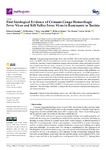2021-06-18Zeitschriftenartikel
First Serological Evidence of Crimean-Congo Hemorrhagic Fever Virus and Rift Valley Fever Virus in Ruminants in Tunisia
Zouaghi, Khaoula
Bouattour, Ali
Aounallah, Hajer
Surtees, Rebecca
Krause, Eva
Michel, Janine
Mamlouk, Aymen
Nitsche, Andreas
M’ghirbi, Youmna
Crimean-Congo hemorrhagic fever virus (CCHFV, Nairoviridae family) and Rift Valley fever virus (RVFV, Phenuiviridae family) are zoonotic vector-borne pathogens with clinical relevance worldwide. Our study aimed to determine seroprevalences of these viruses and potential risk factors among livestock (cattle, sheep, and goats) in Tunisia. Sera were tested for antibodies against CCHFV (n = 879) and RVFV (n = 699) using various enzyme-linked immunosorbent assays (ELISAs) and indirect immunofluorescence assays (IIFA). The overall seroprevalence of IgG antibodies was 8.6% (76/879) and 2.3% (16/699) against CCHFV and RVFV, respectively. For CCHF seropositivity bioclimatic zones and breed were potential risk factors for the three tested animal species; while the season was associated with cattle and sheep seropositivity, tick infestation was associated with cattle and goats seropositivity and age as a risk factor was only associated with cattle seropositivity. Age and season were significantly associated with RVFV seropositivity in sheep. Our results confirm the circulation of CCHFV and RVFV in Tunisia and identified the principal risk factors in ruminants. This knowledge could help to mitigate the risk of ruminant infections and subsequently also human infections.
Files in this item

